Website owner: James Miller
Cartesian product. Projection function. Product topology. Product space. Subbase and base for product topology. Metric product spaces
Def. Cartesian product A
![]() B of two sets A and B. The Cartesian product A
B of two sets A and B. The Cartesian product A
![]() B
(read “A cross B”) of two sets A and B is defined as the set of all ordered pairs (a, b) where a is
a member of A and b is a member of B.
B
(read “A cross B”) of two sets A and B is defined as the set of all ordered pairs (a, b) where a is
a member of A and b is a member of B.
Syn. Product set, direct product, direct sum.
Example 1. If A = {1, 2, 3} and B = {a, b} the Cartesian product A
![]() B is given by
B is given by
A
![]() B = { (1, a), (1, b), (2, a), (2, b), (3, a), (3, b) }
B = { (1, a), (1, b), (2, a), (2, b), (3, a), (3, b) }

Comments. Some comments are in order in regard to the concept of a Cartesian product of two
arbitrary sets A and B. One is certainly justified in asking: Does this concept make any sense?
What meaning can be attached to a Cartesian product? What meaning can be attached to the
ordered pairs? Well, in general, an ordered pair has no meaning unless one has been assigned.
In specific cases, when an ordered pair does have meaning, the concept of a Cartesian product
becomes meaningful and useful. The Cartesian product finds meaning and use in various places,
for example the theory of such abstract mathematical systems as groups, rings, vector spaces and
topological spaces. One can view the concept of a Cartesian product as a generalization /
abstraction of a concept relating to the Cartesian plane. That concept is this: The set of all points
in the Cartesian plane can be viewed as the set of all ordered pairs (x, y) where x ε R and y ε R,
R being the set of all real numbers. In fact, a Cartesian product is so defined that R
![]() R is the
set of all points in what we know as the Cartesian plane. Thus the motivation for the term. In
analogy to the way we view number pairs (x, y) as
points in the Cartesian plane we can view the
ordered pairs of a Cartesian product as points in a
Cartesian frame. Figure 1 shows such a
representation for the sets A = {1, 2, 3, 4} and B =
{a, b, c}.
R is the
set of all points in what we know as the Cartesian plane. Thus the motivation for the term. In
analogy to the way we view number pairs (x, y) as
points in the Cartesian plane we can view the
ordered pairs of a Cartesian product as points in a
Cartesian frame. Figure 1 shows such a
representation for the sets A = {1, 2, 3, 4} and B =
{a, b, c}.
Example 2. Let A be the set of numbers in the
interval [3, 5] and B be the set of numbers in the
interval [2, 3]. Then the Cartesian product A
![]() B
corresponds to the rectangular region shown in
Fig. 2. It consists of all points (x, y) within the
region. In the same way, if A is the set of numbers
in the interval [3, 5], B is the set of numbers in the
interval [2, 3] and C is the set of numbers in the interval [6, 7] the Cartesian product A
B
corresponds to the rectangular region shown in
Fig. 2. It consists of all points (x, y) within the
region. In the same way, if A is the set of numbers
in the interval [3, 5], B is the set of numbers in the
interval [2, 3] and C is the set of numbers in the interval [6, 7] the Cartesian product A
![]() B
B
![]() C
C
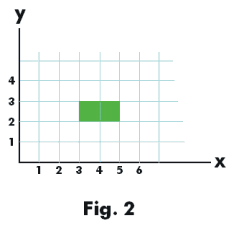
consists of all points (x, y, z) in a rectangular parallelepiped in three-dimensional space defined by
3
![]() x
x
![]() 5
5
2
![]() y
y
![]() 3
3
6
![]() z
z
![]() 7 .
7 .
Example 3. Let I denote the unit interval [0, 1] and
C1 the interior and boundary of the unit circle. Then
I
![]() I is the unit square, C1
I is the unit square, C1
![]() I is a cylinder and
C1
I is a cylinder and
C1
![]() C1 is a torus. See Fig. 3.
C1 is a torus. See Fig. 3.
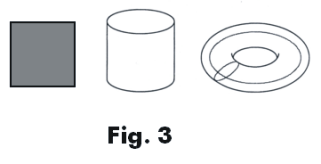
The Cartesian product
A1
![]() A2
A2
![]()
![]()
![]() An . The Cartesian
product A1
An . The Cartesian
product A1
![]() A2
A2
![]()
![]()
![]() An of n sets A1,
A2, ...... , An is the set of all ordered n-tuples (a1, a2, .... , an) for ai ε Ai, where
each ai assumes all the values in Ai, i = 1,
2, ...., n. We can view an n-tuple (a1, a2,
.... , an) as a point in an n-dimensional
space defined by the Cartesian product
A1
An of n sets A1,
A2, ...... , An is the set of all ordered n-tuples (a1, a2, .... , an) for ai ε Ai, where
each ai assumes all the values in Ai, i = 1,
2, ...., n. We can view an n-tuple (a1, a2,
.... , an) as a point in an n-dimensional
space defined by the Cartesian product
A1
![]() A2
A2
![]()
![]()
![]() An . The component sets
A1, A2,
An . The component sets
A1, A2,
![]() , An of the product are called
the coordinate sets of the space. The set Ai is called the i-th coordinate set of the product. The i-th component of the n-tuple (a1, a2, .... , an) is called the i-th coordinate of the vector (a1, a2, .... ,
an) in this n-dimensional space. This i-th coordinate of the point is called the projection of the
vector (a1, a2, .... , an) onto the i-th coordinate set Ai.
, An of the product are called
the coordinate sets of the space. The set Ai is called the i-th coordinate set of the product. The i-th component of the n-tuple (a1, a2, .... , an) is called the i-th coordinate of the vector (a1, a2, .... ,
an) in this n-dimensional space. This i-th coordinate of the point is called the projection of the
vector (a1, a2, .... , an) onto the i-th coordinate set Ai.
The above represents a generalization of concepts associated with the usual 3-space R3 and n-space Rn. The space Rn becomes a special case of the above when A1 = A2 = .... = An = R.
Notations. The Cartesian product A1
![]() A2
A2
![]()
![]()
![]() Ai
Ai
![]()
![]() of an indexed collection of sets
{Ai}i ε I is sometimes denoted by
of an indexed collection of sets
{Ai}i ε I is sometimes denoted by
![]()
Projection function. There is a function called the projection function that works as follows:
Let X = (a1, a2, .... , an) be a point in the n-dimensional space defined by the Cartesian product
A1
![]() A2
A2
![]()
![]()
![]() An . The projection function πi(X) is defined as
An . The projection function πi(X) is defined as
πi(X) = ai
where ai is the i-th coordinate of the point X = (a1, a2, .... , an). Here ai represents the projection
of the vector (a1, a2, .... , an) onto the i-th coordinate set Ai , hence the name. The projection
function π is a function from the n-dimensional space defined by the Cartesian product
A1
![]() A2
A2
![]()
![]()
![]() An into the i-th coordinate set Xi.
An into the i-th coordinate set Xi.
Example 4. Let R1, R2 and R3 denote copies of R. Consider the point X = (3.1, 6.5, 2.8) in
three dimensional space R3 = R
![]() R
R
![]() R = R1
R = R1
![]() R2
R2
![]() R3. Then
R3. Then
π1(X) = 3.1 is the projection of X in R1.
π2(X) = 6.5 is the projection of X in R2.
π3(X) = 2.8 is the projection of X in R3.
Cartesian product R
![]() R
R
![]() R. The Cartesian product R
R. The Cartesian product R
![]() R
R
![]() R corresponds to the set of all
points in three-dimensional space i.e. the set of all number triplets (x, y, z), x ε R, y ε R, z ε R.
R corresponds to the set of all
points in three-dimensional space i.e. the set of all number triplets (x, y, z), x ε R, y ε R, z ε R.
Cartesian products R2, R3, .... , Rn. The Cartesian product R
![]() R is usually denoted by R2, the
Cartesian product R
R is usually denoted by R2, the
Cartesian product R
![]() R
R
![]() R is usually denoted by R3 and the Cartesian product
R
R is usually denoted by R3 and the Cartesian product
R
![]() R
R
![]() .....
.....
![]() R (n times) consisting of all n-tuples (x1, x2, .... , xn) is usually denoted by Rn.
R (n times) consisting of all n-tuples (x1, x2, .... , xn) is usually denoted by Rn.
Generally a Cartesian product A
![]() B is thought of as a two dimensional array of points with each
point corresponding to an ordered pair (x, y), a Cartesian product A
B is thought of as a two dimensional array of points with each
point corresponding to an ordered pair (x, y), a Cartesian product A
![]() B
B
![]() C is thought of as a
three dimensional array of points with each point corresponding to an ordered triple (x, y, z) and
a Cartesian product A1
C is thought of as a
three dimensional array of points with each point corresponding to an ordered triple (x, y, z) and
a Cartesian product A1
![]() A2
A2
![]()
![]()
![]() An is thought of as an n-dimensional array of points with
each point corresponding to an n-tuple (or n-vector). An exception to this is illustrated in
Example 3 above because C1 is two-dimensional.
An is thought of as an n-dimensional array of points with
each point corresponding to an n-tuple (or n-vector). An exception to this is illustrated in
Example 3 above because C1 is two-dimensional.
Product topology. Product space.
Def. Product topology. Let X and Y be
topological spaces. The product topology on
the Cartesian product X
![]() Y of the spaces is
the topology having as base the collection B of
all sets of the form U
Y of the spaces is
the topology having as base the collection B of
all sets of the form U
![]() V, where U is an open
set of X and V is an open set of Y.
V, where U is an open
set of X and V is an open set of Y.
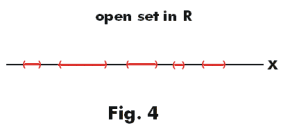
Example 5. Consider the interpretation of
this definition for the case when X and Y are R, the set of real numbers. Open sets in R
correspond to collections of open intervals. See Fig. 4. U and V are open sets in R and the
collection B of all sets of the form U
![]() V is a base for the product topology on R
V is a base for the product topology on R
![]() R.
R.
Base for product topology
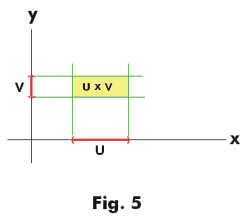
Theorem 1. If B is a base for the topology of X and C is a base for the topology of Y, then the collection
D = {B
![]() C: B ε B and C ε C}
C: B ε B and C ε C}
is a base for the topology of X
![]() Y.
Y.
Example 6. Consider the interpretation of this
theorem for the case when X and Y are R, the set of
real numbers. The open intervals on the real line
constitute a base for the collection of all open sets
of real numbers. Let U be an open interval (a, b) in
X and V be an open interval (c, d) in Y. Then the
collection of all open sets of the form U
![]() V is a
base for the product topology on R
V is a
base for the product topology on R
![]() R. See Fig. 5.
Every open set of R
R. See Fig. 5.
Every open set of R
![]() R is the union of some of the
members of this base. These open rectangles form a
base for the product topology on R2, which is the
usual topology on R2.
R is the union of some of the
members of this base. These open rectangles form a
base for the product topology on R2, which is the
usual topology on R2.
We thus see that while the definition gives as a base for a topology on R2 the collection of all
products of open sets of R, the theorem provides us with a much smaller collection of all
products (a, b)
![]() (c, d) of open intervals in R.
(c, d) of open intervals in R.
Def. Product space. Let {(Xi, Ti)} be a collection of topological spaces and let X
![]()
be the product of the sets Xi. The product set X with the product topology T is called the product topological space or simply the product space.
Theorem 3. Let X1, X2, .... , Xm be a finite number of topological spaces and let
X = X1
![]() X2
X2
![]() ....
....
![]() Xm
Xm
be the product space. Then the collection of subsets
G1
![]() G2
G2
![]() ....
....
![]() Gm ,
Gm ,
where Gi is an open subset of Xi, form a base for the product topology on X.
Subbase for product topology
Let X and Y be topological spaces. Let (x, y) be a
point in the space X
![]() Y. The projection function
π1: X
Y. The projection function
π1: X
![]() Y
Y
![]() X is, by definition,
X is, by definition,
π1(x, y) = x
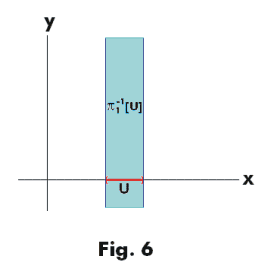
and π2: X
![]() Y
Y
![]() Y is
Y is
π2(x, y) = y .
The maps of π1 and π2 are called the projections of
X
![]() Y onto X and Y, respectively.
Y onto X and Y, respectively.
If U is an open subset of X, then the set π1-1[U] is
the set U
![]() Y, an open set of X
Y, an open set of X
![]() Y (the set π1-1[U] is that subset of X
Y (the set π1-1[U] is that subset of X
![]() Y that projects into U).
See Fig. 6. Similarly, if V is an open subset of
Y, then the set π2-1[V] is the set V
Y that projects into U).
See Fig. 6. Similarly, if V is an open subset of
Y, then the set π2-1[V] is the set V
![]() X, also an
open set of X
X, also an
open set of X
![]() Y (the set π2-1[V] is that subset
of X
Y (the set π2-1[V] is that subset
of X
![]() Y that projects into V). See Fig. 7.
Y that projects into V). See Fig. 7.
The intersection of these two sets U
![]() Y and V
Y and V
![]() X is the set U
X is the set U
![]() V shown in Fig. 8.
V shown in Fig. 8.
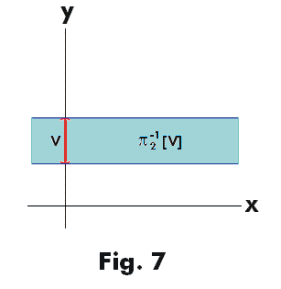
Theorem 4. The collection
![]()
where U and V are open subsets in X and Y
respectively is a subbase for the product topology on X
![]() Y.
Y.
Theorem 5. Let X1, X2, .... . , Xm be a set of topological spaces and let
X = X1
![]() X2
X2
![]() ....
....
![]() Xm
Xm
be the product space. Then the collection of subsets
![]()
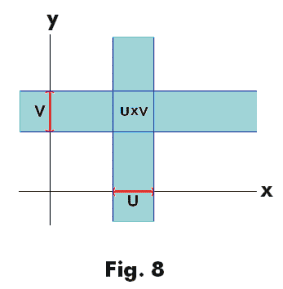
where Gi is an open subset of Xi is a subbase for the product topology on X. It is called the defining subbase for the product topology.
Since finite intersections of the subbase elements form a base for the topology we have:
Theorem 6. Let X1, X2, .... , Xm be a set of topological spaces and let
X = X1
![]() X2
X2
![]() ....
....
![]() Xm
Xm
be the product space. Then the collection
![]()
where Gi is an open subset of Xi is a base for the product topology on X. It is called the defining base for the product topology.
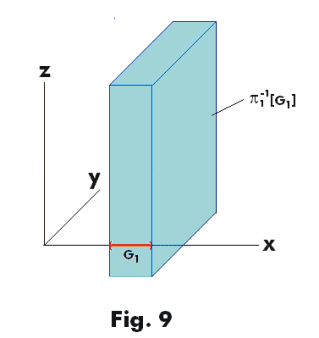
General expression for πi-1[Gi] .
The subset πi-1 [Gi] is that subspace of the
product space that projects into the open
set Gi . If we are considering two topological spaces X and Y the subspace of the product space
X
![]() Y that projects into G1 is G1
Y that projects into G1 is G1
![]() Y where G1 is an open set in X. If we are considering three
topological spaces X, Y and Z the subspace of the product space X
Y where G1 is an open set in X. If we are considering three
topological spaces X, Y and Z the subspace of the product space X
![]() Y
Y
![]() Z that projects into G1
is G1
Z that projects into G1
is G1
![]() Y
Y
![]() Z where G1 is an open set in X. See Fig. 9. The general formula for πi-1[Gi] for the
case of m topological spaces X1, X2, .... , Xm is
Z where G1 is an open set in X. See Fig. 9. The general formula for πi-1[Gi] for the
case of m topological spaces X1, X2, .... , Xm is
![]()
Infinite sequences. Consider the case of an infinite but denumerable set of topological spaces X1, X2, X3, .... The product space
X = X1
![]() X2
X2
![]() X3
X3
![]()
![]()
then consists of all sequences
p = {a1, a2, a3, ...... } where an ε Xn
In addition, if Gi is an open subset in Xi, then
![]()
Theorem 7. Let {(Xi, Ti)} be a collection of topological spaces and let X be the product of the sets Xi, i.e.
![]()
The coarsest topology T on X with respect to which all the projections πi: X
![]() Xi are continuous
is the (Tychonoff) product topology.
Xi are continuous
is the (Tychonoff) product topology.
We note that with the product topology, as it has been defined, all the projections are continuous since a function f is continuous if and only if the inverse of each open set in the range R of f is open in the domain D.
Theorem 8. For a Cartesian product of a finite number of topological spaces X1, X2, .... , Xn, a set is open in the product if and only if it is a product of sets U1, U2, ...... , Un , where Uk is open in Xk for each k. With this topology for the Cartesian product, it can be shown that the Cartesian product is compact if and only if each Xi is compact.
James & James. Mathematics Dictionary
Theorem 9. A function from a topological space Y into a product space
![]()
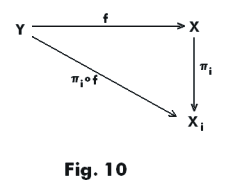
is continuous if and only if, for every projection πi: X
![]() Xi, the composition mapping
Xi, the composition mapping
![]()
is continuous. See Fig. 10.
Theorem 10. Every projection πi: X
![]() Xi on a product space
Xi on a product space
![]()
is both open and continuous i.e. it is a bicontinuous mapping.
Theorem 11. A sequence p1, p2, p3, ..... of points in a product space
![]()
converges to the point q in X if and only if,
for every projection πi: X
![]() Xi, the
sequence πi(p1), πi(p2), πi(p3), ..... converges
to πi(q) in the coordinate space Xi.
Xi, the
sequence πi(p1), πi(p2), πi(p3), ..... converges
to πi(q) in the coordinate space Xi.

Functions viewed as infinite
dimensional vectors. A function can
be viewed as an infinite dimensional vector
in the space
![]() . Let
us consider the basis for this viewpoint.
Let a function y = f(x) be defined on the
interval [0, 1]. Divide the interval [0, 1]
into equal sub-intervals with the points x1 = 0, x2, x3, .... , xn = 1 as shown in Fig. 11 and let
. Let
us consider the basis for this viewpoint.
Let a function y = f(x) be defined on the
interval [0, 1]. Divide the interval [0, 1]
into equal sub-intervals with the points x1 = 0, x2, x3, .... , xn = 1 as shown in Fig. 11 and let
yi = f(xi) , i = 1, n
The function can thus be represented as the sequence of n numbers {y1, y2, ..... , yn }, an n-tuple, a
point in n-dimensional space. Now let n
![]() and the function is represented as an infinite
sequence {y1, y2, y3, .....}, a point in
and the function is represented as an infinite
sequence {y1, y2, y3, .....}, a point in
![]() .
.
Let R1, R2, R3, .... be copies of R with the usual topology. Then the product space
![]()
consists of all sequences
p = {a1, a2, a3, ...... } where ai ε Ri
If we equate infinite sequences with functions we see that the product space
![]() consists of the
set of all real-valued functions.
consists of the
set of all real-valued functions.
We can state these ideas somewhat differently. Let Ri denote a copy of R. Conceive of the set {Ri} as being indexed by points in the closed interval A = [0, 1]. Then the product space is
![]()
A point p of the product space
![]() consists of a function y = f(x) i.e. an infinite sequence
consists of a function y = f(x) i.e. an infinite sequence
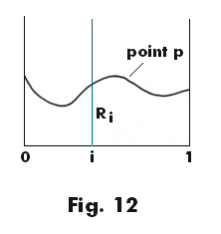
p = {y1, y2, y3, .....}
In Fig. 12 is depicted a point p in
![]() . Each vertical line at a point i in the interval [0, 1]
represents the coordinate space Ri . The value yi of the
function at the point i is the i-th coordinate of p and
corresponds to the projection of the point p on the
coordinate set Ri .
. Each vertical line at a point i in the interval [0, 1]
represents the coordinate space Ri . The value yi of the
function at the point i is the i-th coordinate of p and
corresponds to the projection of the point p on the
coordinate set Ri .
Let us now describe one of the members of the defining
subbase S for the product topology on
![]() . The subbase
S consists of all of the subsets of
. The subbase
S consists of all of the subsets of
![]() of the form πi-1 [Gi]
where Gi is an open subset of the coordinate set Ri .
Suppose Gi is the open interval (2, 3). Then πi-1 [Gi]
consists of all points p in
of the form πi-1 [Gi]
where Gi is an open subset of the coordinate set Ri .
Suppose Gi is the open interval (2, 3). Then πi-1 [Gi]
consists of all points p in
![]() such that ai ε Gi = (2, 3).
Graphically, πi-1 [Gi] consists of all those functions
passing through the open interval Gi = (2, 3) on the
vertical line representing the coordinate set Ri. See Fig. 13.
such that ai ε Gi = (2, 3).
Graphically, πi-1 [Gi] consists of all those functions
passing through the open interval Gi = (2, 3) on the
vertical line representing the coordinate set Ri. See Fig. 13.
Now let us describe one of the open sets of the defining base B for the product topology on
![]() .
.
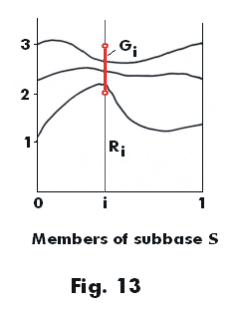
Denote the open set by B. Then B is the intersection of a finite number of the members of the defining subbase S for the product topology, say,
![]()
B thus consists of all points p common to the three
intervals
![]() of coordinates sets
of coordinates sets
![]() . Graphically, B consists of all functions
passing through the open sets
. Graphically, B consists of all functions
passing through the open sets
![]() which lie
on the vertical lines denoting the coordinate sets
which lie
on the vertical lines denoting the coordinate sets
![]() . See Fig. 14. One can visualize it as a
bundle of fibers.
. See Fig. 14. One can visualize it as a
bundle of fibers.
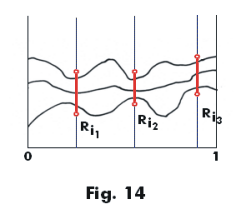
Def. Product invariant property.
A property P of a topological space is said to be product invariant if a product space
![]()
possesses P whenever each coordinate set Xi possesses P.
Tychonoff theorem. The product of compact spaces is compact.
Metric product spaces
Theorem 12. Let (X1, d1), (X2, d2), .......... ,(Xm, dm ) be metric spaces and let p = (a1, .... , am) and q = (b1, .... , bm) be arbitrary points in the product set

Then each of the following functions is a metric on the product set X:
![]()

Moreover, the topology on X induced by each of the above metrics is the product topology.
Theorem 13. Let (X1, d1), (X2, d2), .......... ,(Xm, dm ) be a denumerable collection of metric spaces and let p = (a1, a2, .... ) and q = (b1, b2 .... ) be arbitrary points in the product set

Then the function d defined by

is a metric on the product set X and the topology induced by d is the product topology.
References
1. Lipschutz. General Topology
2. Simmons. Introduction to Topology and Modern Analysis
3. Munkres. Topology, A First Course
4. James & James. Mathematics Dictionary
Jesus Christ and His Teachings
Way of enlightenment, wisdom, and understanding
America, a corrupt, depraved, shameless country
On integrity and the lack of it
The test of a person's Christianity is what he is
Ninety five percent of the problems that most people have come from personal foolishness
Liberalism, socialism and the modern welfare state
The desire to harm, a motivation for conduct
On Self-sufficient Country Living, Homesteading
Topically Arranged Proverbs, Precepts, Quotations. Common Sayings. Poor Richard's Almanac.
Theory on the Formation of Character
People are like radio tuners --- they pick out and listen to one wavelength and ignore the rest
Cause of Character Traits --- According to Aristotle
We are what we eat --- living under the discipline of a diet
Avoiding problems and trouble in life
Role of habit in formation of character
Personal attributes of the true Christian
What determines a person's character?
Love of God and love of virtue are closely united
Intellectual disparities among people and the power in good habits
Tools of Satan. Tactics and Tricks used by the Devil.
The Natural Way -- The Unnatural Way
Wisdom, Reason and Virtue are closely related
Knowledge is one thing, wisdom is another
My views on Christianity in America
The most important thing in life is understanding
We are all examples --- for good or for bad
Television --- spiritual poison
The Prime Mover that decides "What We Are"
Where do our outlooks, attitudes and values come from?
Sin is serious business. The punishment for it is real. Hell is real.
Self-imposed discipline and regimentation
Achieving happiness in life --- a matter of the right strategies
Self-control, self-restraint, self-discipline basic to so much in life